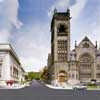Claire and Marc Bourgie Pavilion, Montreal Museum of Fine Arts, MMFA building design images
Claire and Marc Bourgie Pavilion, Montreal, Canada
New Pavilion of Quebec and Canadian Art, Québec, Canada
post updated 29 March 2024
The Future Pavilion Of Canadian Art Of The Montreal Museum Of Fine Arts
Will Bear The Name Of A Montreal Family Of Patrons
Design: Provencher Roy + Associés architects
The new wing of the museum opens in September 2011.
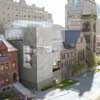
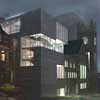
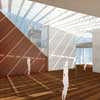
pictures © Montreal Museum of Fine Arts
12 May 2011
New Pavilion of Quebec and Canadian Art – Montreal Museum of Fine Arts
“This addition will double the space available for our collection of Canadian art. There’ll be space for 600 works on six floors,” said MMFA director Nathalie Bondil at a recent media preview.
Video (rather long) showing relationship of the new pavilion to the Erskine and American Church:
Claire and Marc Bourgie Pavilion from MBAM on Vimeo.
Claire and Marc Bourgie Pavilion from MBAM on Vimeo.
Previously:
Claire and Marc Bourgie Pavilion Montreal
THE MONTREAL MUSEUM OF FINE ARTS UNVEILS THE ARCHITECTURE OF ITS NEW PAVILION OF QUEBEC AND CANADIAN ART AND ITS NEW CONCERT HALL
Montreal, April 20, 2011 – After many months of work, construction of the Claire and Marc Bourgie Pavilion of Quebec and Canadian Art at the Montreal Museum of Fine Arts (MMFA) and restoration of the 1894 heritage church, which has been converted to a 444‐seat concert hall, have been completed. Both the schedule and the budget have been respected. The Museum’s curators, led by Nathalie Bondil, the MMFA’s Director and Chief Curator, will soon begin the task of installing the 600 works in the six new floors. The new pavilion will open to the public this fall.
The Museum, which celebrated its 150th anniversary in 2010, is expanding once again, thanks to the unwavering determination of the Museum’s former Chairman of the Board, Bernard Lamarre, who initiated the project, and Brian M. Levitt, the current Chairman.
The addition of this fourth pavilion will more than double the area devoted to Quebec and Canadian art. In this new building (which has already received two awards – the 2010 Canadian Architect Awards of Merit and the 2011 Award of Excellence from the Urban Development Institute of Quebec), the Museum will soon be presenting a unique and coherent look at the history of Quebec and Canadian art.
With admission and audioguides free of charge at all times, the new Claire and Marc Bourgie Pavilion will give thousands of visitors, school groups, families and tourists an opportunity to learn more about our heritage, which will be shown here in a historical context. The Bourgie Concert Hall, which will present numerous concerts and activities every year, will help spark a new dialogue between the visual arts and music.
The Claire and Marc Bourgie Pavilion of Quebec and Canadian Art: saving and restoring a heritage monument
This innovative expansion project includes a heritage building, the Erskine and American Church, deconsecrated in 2004 and acquired by the Museum in 2008. With this acquisition, the Museum embarked on a project that is unique in Canada: on one hand, a pavilion with a resolutely contemporary look, on the other, a concert hall in a Romanesque Revival building more than a century old. Joining the two buildings together made it possible to preserve a “national historic site.” A model of architectural conversion, it also serves as an example internationally, since few such projects exist.
This project, which called for an ingenious design and presented complex engineering challenges, was assigned to Provencher Roy + Associés architects, and led by Claude Provencher and Matthieu Geoffrion, who worked with 450 professionals and craftsmen on this huge building site. The basic premise was to combine the museum function with a church built in the late‐nineteenth century. Transforming part of the structure to be able to display works was a necessary choice, since it was not possible to adapt it to meet the museological conservation requirements for works of art.
The church had already undergone remodelling, including one in 1938, which involved separating the sanctuary from the other community functions at the rear of the church. Not only is the museum function an ideal fit with the church, giving it a new life, it also makes it possible to conserve a “Canadian architectural treasure.”
In awarding its 2011 Excellence Award to the architects of the Claire and Marc Bourgie Pavilion, the Urban Development Institute of Quebec congratulated Provencher Roy + Associés architectes for their in‐depth reflection on the challenges presented by the project, its exceptional urban integration and its design, which brings past and future together.
Attention to architectural harmony
Despite what may at first appear to be a rather architectural eclectic complex – four pavilions from very different eras and with differing structures – attention to the architectural harmony between the new pavilion and the other pavilions was an imperative from the outset and an essential requirement for the architects at Provencher Roy + Associés. They had to find materials that, although specific to the new contemporary section, were also consistent with the existing church and with the Museum’s other pavilions.
The white marble used for the Michal and Renata Hornstein Pavilion (architects Edward & W.S. Maxwell) and the Jean‐Noël Desmarais Pavilion (architect Moshe Safdie) was the ideal choice for the exterior of the new pavilion, thereby completing a trilogy with the existing buildings and forming a coherent whole. Marble and walls of clear glass for the fenestration of the new architecture set it apart from the church but are cohesive with the Museum’s other pavilions, the white marble linking them physically and symbolically. The use of marble for the three buildings is also unique in Montreal and in Quebec, where this lavish material is not often used.
It comes from the same quarry in Vermont that provided the marble for the Michal and Renata Hornstein Pavilion in 1912 and the Jean‐Noël Desmarais Pavilion in 1991. The 1,500 sheets of white marble covering the outer walls of the Claire and Marc Bourgie Pavilion were installed so that the veins in the marble form a coherent pattern, creating a stone mural. Thus, twenty‐seven successive cuts from sixteen blocks originating in the same wall of the quarry reproduce the same configuration of veins twenty‐seven times.
A unique setting for our heritage works
The fourth pavilion adds two thousand square metres of gallery space, more than doubling the area for the presentation of Quebec and Canadian art and increasing the MMFA’s total exhibition space by 20%. This expansion means that a substantial number of works from the Museum’s outstanding collections of historical and modern Quebec and Canadian art will be on display.
The project’s architects used glass walls to create an airy, light‐filled space on each floor of the new pavilion, at the entrance to each gallery, and allow for a connection with the city. On the top level, a magnificent glassed‐in gallery affords a stunning view of Mount Royal.
A complex heritage restoration
Saving the Erskine and American Church was central to the Museum’s expansion project. In acquiring this church, the MMFA wanted to restore it and give it a new purpose. Far from being the least expensive option, this responsible and heritage solution proved to be more arduous than building a new structure. It is important to point this out, since the contrary might be assumed in the case of an existing building. “This choice by the Museum is a major initiative to beautify our city,” says Nathalie Bondil, the Museum’s Director. “
The Museum planned the project based on recommendations by Jean‐Claude Marsan, urbanist and architect, in his 2006 heritage study. The heritage church to which the new pavilion is attached has been restored in order to conserve the building’s Romanesque Revival architecture, which echoes the massive, powerful style of early Medieval churches. This building, designed in 1894 by Montreal architect Alexander Cooper Hutchison, is a rare example of the Romanesque Revival style in Montreal.
Designated a «national historic site» by Heritage Canada in 1998, for its history and its remarkable architecture, this Church is notable for its imposing façade, an ingenious combination of heavily rusticated grey limestone and lavishly sculpted brown Miramichi sandstone, make it a unique composition in Montreal. By the end of this project, each of the stones will have been restored and cleaned. The majestic dome characteristic of the Byzantine style is also very unusual in Montreal churches.
Previously:
Montreal Museum of Fine Arts Pavilion of Quebec and Canadian Art
Nathalie Bondil, Director of the Montreal Museum of Fine Arts, said that the nave of the Erskine and American Church, part of the future pavilion of Canadian art, will be called “Bourgie Hall.” This 450-seat concert hall will also host educational and cultural activities, related to music and the fine arts, and special events, allowing audiences to discover and take advantage of the riches and the vitality of Montreal’s cultural scene: this is what the Arte Musica Foundation hopes to accomplish.”
The Montreal Museum of Fine Arts recently announced that the new pavilion of Canadian art would officially open in 2010, following confirmation of financial support from the Canadian and Quebec governments, as well as from private donors, in particular, the Bourgie family. The Museum’s management thanks Claire and Marc Bourgie, as well as Pierre Bourgie and Claude Bovet Bourgie, for their exceptional generosity and announced that, as a gesture of appreciation, the future pavilion of Canadian art will be known as the “Claire and Marc Bourgie Pavilion.”
Museum President Bernard Lamarre announced that Provencher Roy, Go Multimédia and designer Michel Dallaire will collaborate on the Bourgie Hall project.
In the past, music played an important role at the Erskine and American Church, and many musical organizations presented concerts there over the years.
There have always been many close ties between music and the visual arts, since both share a desire to convey, via the senses, the indescribable aesthetic emotions that are inherent in a work of art. “Placing music centre-stage at the Museum, and initiating a musical dialogue with its collections and its exhibitions will help to increase understanding, learning and interest in each of these disciplines.
This ‘musical museum’ will take an original, decompartmentalized approach that combines history, performance and artistic creation, both musical and visual, in the collections of visual arts and even musical instruments,” concluded Ms. Bondil.
Claire and Marc Bourgie Pavilion, Montreal
PROVENCHER ROY + ASSOCIÉS ARCHITECTES
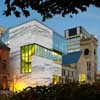
photo © Tom Arban
Claire and Marc Bourgie Pavilion, Montreal
Design: Provencher Roy + Associés architects, led by Claude Provencher and Matthieu Geoffrion
New Pavilion of Quebec and Canadian Art – Montreal Museum of Fine Arts images / information from Provencher Roy + Associés architects
Montreal Museum of Fine Arts Buildings
Michal and Renata Hornstein Pavilion – Beaux Arts building
1912
William Sutherland Maxwell and brother Edward Maxwell
Jean-Noël Desmarais Pavilion
1991
Moshe Safdie
Liliane and David M. Stewart Pavilion
Location: Montreal Museum of Fine Arts, Montreal, Canada
Quebec Buildings
Habitat 67, Montreal, Quebec
Moshe Safdie, Architect
Habitat 67 Buildings
Related Québec Building:
Musée National des Beaux-Arts du Québec – Competition
Extension to the Quebec Provincial Museum
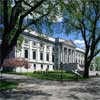
photo © Les Photographes Kedl, 2004
Quebec Museum Competition : The Office for Metropolitan Architecture (OMA) – winner
Comments / photos for the Claire and Marc Bourgie Pavilion, Montreal Museum of Fine Arts page welcome

